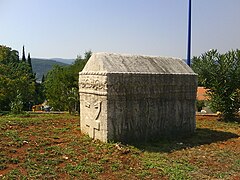
Dubrovnik, historically known as Ragusa, is a city in southern Dalmatia, Croatia, by the Adriatic Sea. It is one of the most prominent tourist destinations in the Mediterranean, a seaport and the centre of the Dubrovnik-Neretva County. Its total population is 41,562. In 1979, the city of Dubrovnik was added to the UNESCO list of World Heritage Sites in recognition of its outstanding medieval architecture and fortified old town.

The Herzegovina-Neretva Canton is one of 10 cantons of the Federation of Bosnia and Herzegovina in Bosnia and Herzegovina.

The Dubrovnik-Neretva County is the southernmost county of Croatia. The county seat is Dubrovnik and other large towns are Korčula, Metković, Opuzen and Ploče. The Municipality of Neum, which belongs to neighbouring Bosnia and Herzegovina, divides the county in two parts which are connected only by the Pelješac Bridge. The southern part of the county consists of Dubrovnik and the surrounding area, including the Pelješac peninsula, and the islands of Korčula, Lastovo, Mljet, Šipan, Lopud and Koločep. The northern part of the county includes the Neretva Delta, the Baćina lakes north of Ploče, and a swath of hinterland near the southernmost slopes of Biokovo and around the hill of Rujnica. The northern part of the Mljet island is a national park. The Lastovo archipelago is a designated nature park. The southernmost tip of the county is the Prevlaka peninsula at the border with Montenegro. It is the only Croatian county that borders Montenegro.

Pelješac is a peninsula in southern Dalmatia in Croatia. The peninsula is part of the Dubrovnik-Neretva County and is the second largest peninsula in Croatia. From the isthmus that begins at Ston, to the top of Cape Lovišta, it is 65 km or 40 mi long.

Čapljina is a city located in Herzegovina-Neretva Canton of the Federation of Bosnia and Herzegovina, an entity of Bosnia and Herzegovina. It is located on the border with Croatia a mere 20 kilometres (12 mi) from the Adriatic Sea.
The History of Dalmatia concerns the history of the area that covers eastern coast of the Adriatic Sea and its inland regions, from the 2nd century BC up to the present day. The region was populated by Illyrian tribes around 1,000 B.C, including the Delmatae, who formed a kingdom and for whom the province is named. Later it was conquered by Rome, thus becoming the province of Dalmatia, part of the Roman Empire. Dalmatia was ravaged by barbaric tribes in the beginning of the 4th century.

The Republic of Ragusa was an aristocratic maritime republic centered on the city of Dubrovnik in South Dalmatia that carried that name from 1358 until 1808. It reached its commercial peak in the 15th and the 16th centuries, before being conquered by Napoleon's French Empire and formally annexed by the Napoleonic Kingdom of Italy in 1808. It had a population of about 30,000 people, of whom 5,000 lived within the city walls. Its motto was "Non bene pro toto libertas venditur auro", a Latin phrase which can be translated as "Liberty is not well sold for all the gold".

The Pelješac Bridge is a cable-stayed bridge in Dubrovnik-Neretva County, Croatia. The bridge provides a fixed link from the southeastern Croatian semi-exclave to the rest of the country while bypassing Bosnia and Herzegovina's short coastal strip at Neum. The bridge spans the sea channel between Komarna on the northern mainland and the peninsula of Pelješac, thereby passing entirely through Croatian territory and avoiding any border crossings with Bosnia and Herzegovina at Neum.

The Adriatic Highway is a road that stretches along the eastern coast of the Adriatic Sea and is part of the European route E65. The road passes through Croatia, with smaller stretches through Bosnia and Herzegovina and Montenegro and ends at the Montenegro-Albania border. It is an undivided two-lane road for almost its entire length, with the exception of a short stretch through Zadar and a 24 kilometres (15 mi) dual-carriageway section from Plano (Trogir) to the southeast suburbs of Split. It was planned in the 1930s and built in the 50s and 60s. The dual carriageway is planned to be extended further southeast to Omiš. Completion of the Adriatic Ionian motorway is proposed in order to replace Adriatic Highway as a high-performance road transport route along the Adriatic coast.

The D8 state road is the Croatian section of the Adriatic Highway, running from the Slovenian border at Pasjak via Rijeka, Senj, Zadar, Šibenik, Split, Opuzen and Dubrovnik to the border with Montenegro at Karasovići. Most of the D8 state road remains single carriageway, though with some dual carriageway stretches. The total length of the road through Croatia is 643.1 kilometres (399.6 mi).

Herzegovina is the southern and smaller of two main geographical regions of Bosnia and Herzegovina, the other being Bosnia. It has never had strictly defined geographical, cultural or historical borders, nor has it ever been defined as an administrative whole in the geopolitical and economic subdivision of Bosnia and Herzegovina.

The foreign relations between Bosnia and Herzegovina (BiH) and Croatia are bound together by shared history, language, neighboring geography and cultural commonalties. They established diplomatic relations in 1992, following the dissolution of Yugoslavia and independence of Croatia. The two countries share a 932-kilometer (579 mi) border – the second longest external land border in the European Union (EU). Modern relations between the two states are functional but remain tense after ineffective 21st-century attempts at détente.

Bay of Mali Ston is a bay in the Adriatic Sea, enclosed by the Pelješac peninsula and the mainland. The name primarily refers to the innermost, eastern part of the bay, while the name Channel of Mali Ston is used for the channel between the peninsulas of Klek and Pelješac, in the west. The two bodies of water are located in Croatia's and partly in Bosnia and Herzegovina's territorial waters.
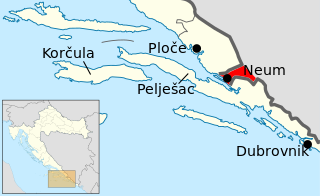
The Neum Agreement is an unimplemented treaty between Croatia and Bosnia and Herzegovina granting free passage of Croatian transit traffic between parts of the territory of Dubrovnik-Neretva County. So from the area around the city of Dubrovnik to the rest of the county, thus forming a pene-exclave within the Dubrovnik-Neretva County at the municipality of Neum.
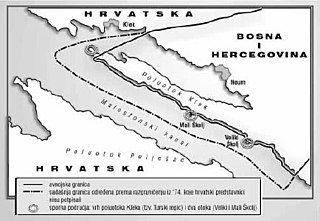
Klek is a peninsula in the Adriatic Sea located southwest of Neum, Bosnia and Herzegovina. It encloses the Bay of Neum, separating it from the larger Bay of Mali Ston and the Pelješac peninsula. At the cape of the peninsula, a few hundred meters from the shore, is a small islet as part of a reef consisting series of bare rocks appearing under the water table. It is called Lopata, and at the tip of the reef there is a lighthouse, also called Lopata. At the very tip of the peninsula, there is another lighthouse, called Rep Kleka.
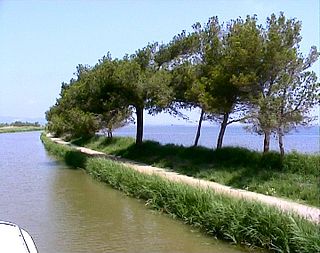
EuroVelo 8 (EV8), named the Mediterranean Route, is a 7,560 km (4,700 mi) long EuroVelo long-distance cycling route running from Cadiz, Spain to Athens, Greece, and then continuing to İzmir, Turkey and to the island of Cyprus. The route runs east-west across Europe mainly along or close to the Mediterranean coast, passing successively through 12 countries: Spain, France, Monaco, Italy, Slovenia, Croatia, Bosnia-Herzegovina, Montenegro, Albania, Greece, Turkey, and Cyprus.
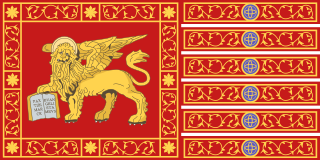
Venetian Dalmatia refers to parts of Dalmatia under the rule of the Republic of Venice, mainly from the 15th to the 18th centuries. Dalmatia was first sold to Venice in 1409 but Venetian Dalmatia was not fully consolidated until 1420. It lasted until 1797, when the Republic of Venice fell to the forces of Napoleon Bonaparte and Habsburg Austria.
The Sutorina dispute was a border dispute between Montenegro and Bosnia and Herzegovina regarding the sovereignty over the territory of Sutorina. Since the Berlin Congress of 1878 the territory of Sutorina had been a part of Bosnia and Herzegovina within Austria-Hungary and later the Kingdom of Yugoslavia, but in the aftermath of World War II in 1947 it became part of SR Montenegro within FPR/SFR Yugoslavia. After the breakup of Yugoslavia, control of the territory was retained by Montenegro, but some Bosnian officials claimed that the territory transfer had been illegal, disputing Montenegrin sovereignty over the area. In 2015, the two countries reached an agreement which gave the sovereignty over the territory to Montenegro.

The Battle of Vukov Klanac was a 7-day fight between Wehrmacht and Yugoslav Partisan forces in central Dalmatia. The battle occurred between 15 and 23 October 1944. It occurred in the region between Metković and Ston as Wehrmacht forces retreated from the nearby cities of Dubrovnik and Ston. It resulted in the 369th Devil's Division losing most of its equipment and a large fraction of its manpower to Partisan forces.
Bosansko Primorje,, is a historical coastal region on the eastern Adriatic shores, which between the beginning of the 14th and the end of the 17th century stretched from the Neretva river delta to Kuril area of Petrovo Selo, near today's Dubrovnik, above Mokošica in Rijeka Dubrovačka. This region is referred in historiography as the Bosansko Primorje, Bosnian Littoral or Bosnian Coast.















